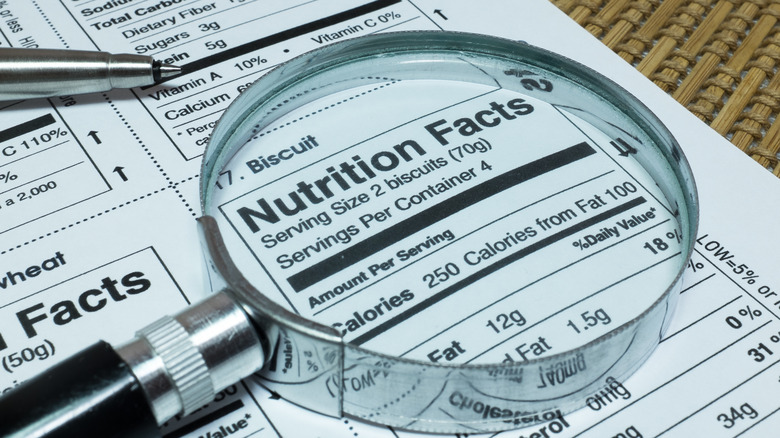The Misleading Methodology Of Serving Size Labels
A lot of us depend on food labels on packaging to guide us when making decisions about what to eat. Some use them for monitoring caloric intake, especially if their aim is to lose a few pounds, while others may look at the label, shrug, and buy one more pint of ice cream.
Nutrition labels as we know them were standardized in January 1993 after the passage of the Nutrition Labeling and Education Act (NLEA) of 1990. The NLEA granted the Food and Drug Administration (FDA) authority to require nutritional food labeling on anything that the FDA regulates, which includes everything from eggs to gum. Nutritional information initially remained voluntary for items like raw fruits, vegetables, and fish, but meat and poultry were regulated differently (via the National Library of Medicine).
Serving sizes on nutrition labels are shown in cups, tablespoons, pieces, or slices — common units of food measurement. The metric amount in grams typically follows underneath. Nutritional information, such as calories, sodium, and protein amounts, is based on the serving size amount (via FDA). However, what some consumers might not be aware of is where this data is coming from and what it actually means.
The label may not reflect the healthiness of a serving size
What many may not know is that the recommendations seen on nutrition labels are based on what people typically consume as opposed to what they should consume. The FDA maintains guidelines for food manufacturers, and sometimes, those guidelines are updated. The updates serve to align servings sizes closer to what people are actually putting in their mouths — a method that is mandated by law. This is to ensure that the data on the label is as accurate as possible.
The serving sizes, however, are not "recommended serving sizes" — they are not what is actually nutritionally beneficial to consumers. The most recent update to the Reference Amounts Customarily Consumed is based on data collected from 2003 to 2008. Ice cream has seen a serving size increase from two-thirds of a cup to half a cup (a pint of ice cream is now three servings), while yogurt's serving size is six ounces, down from eight ounces (via FDA). With serving and portion sizes increasing year by year, this might not be the healthiest way to determine how much you should eat or drink.
If you're looking at the nutrition information to gauge how much to eat, think twice about that suggested serving size. What you or the packaging deems to be an appropriate serving size might be way off. Your doctor can give you more insight into how to maintain a healthy diet.

